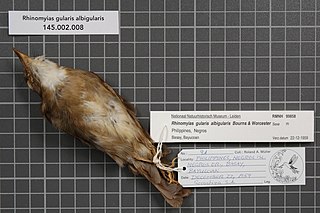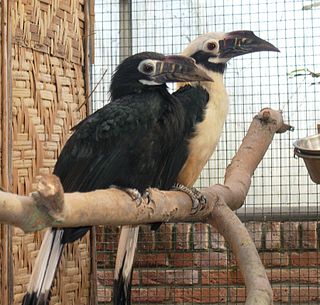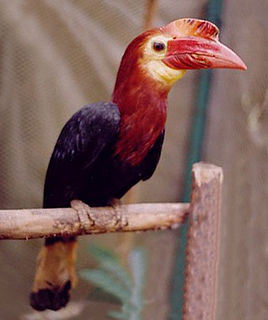 W
WThe flame-templed babbler is a species of bird of the family Zosteropidae, in the genus Dasycrotapha. It is endemic to the Philippines, in the islands of Panay and Negros. Its natural habitat is subtropical or tropical moist lowland forest. It is threatened by habitat loss.
 W
WThe Negros bleeding-heart pigeon is endemic to the Philippines where it is found on the islands of Negros and Panay. It is critically endangered; continuing rates of forest loss on the two islands where it occurs suggest that it will continue to decline. The species has an extremely small, severely fragmented population. The bird is listed as an EDGE species under the analysis of the Zoological Society of London.
 W
WThe white-winged cuckooshrike, also known as white-winged cicadabird or white-winged graybird, is a species of bird in the family Campephagidae. It is endemic to the Philippines. Some taxonomists place this species in the genus Analisoma.
 W
WThe Negros fruit dove is a species of bird in the pigeon and dove family, Columbidae. It is endemic to the island of Negros in the Philippines. This fruit dove is known from a single female specimen collected from the slopes of Mount Kanlaon in the northern part of the island. While it was found at a high elevation, it is suspected that the species originally lived in the lowland dipterocarp forests and was driven to higher elevations by habitat destruction. While some have suggested that the specimen is either a runt or a hybrid instead of a valid species, this is not widely accepted. The female Negros fruit dove was a small fruit dove with vivid dark green plumage and an ashy-grey forehead. It had a distinctive ring of bare yellow skin around its eye, and yellow fringes to some of its feathers gave it the appearance of having a yellow wingbar when perched. The throat was white, while the undertail and vent were yellow.
 W
WThe yellow-faced flameback is a species of bird in the family Picidae. It is found on the Philippine islands of Negros, Guimaras, Panay, Masbate, and Ticao. It is sometimes considered a subspecies of the greater flameback.
 W
WThe black-belted flowerpecker or visayan flowerpecker, is a species of bird in the family Dicaeidae. It is endemic to the Philippines where it is restricted to Panay, Negros and Guimaras islands. It was formerly regarded as a subspecies of the more widespread red-keeled flowerpecker. Sometimes the name red-keeled flowerpecker is used for D. haematostictum and D. australe is then known as the red-sided flowerpecker.
 W
WThe white-throated jungle flycatcher is a species of bird in the Old World flycatcher family Muscicapidae. It is endemic to the Philippines. The natural habitats of the white-throated jungle flycatcher are tropical moist lowland forests and tropical moist montane forests. It is threatened by habitat loss.
 W
WThe Visayan hornbill is a hornbill found in rainforests on the islands of Panay, Negros, Masbate, and Guimaras, and formerly Ticao, in the Philippines. It formerly included all other Philippine tarictic hornbills as subspecies, in which case the common name of the 'combined species' was shortened to tarictic hornbill.
 W
WWalden's hornbill locally called dulungan, also known as the Visayan wrinkled hornbill, rufous-headed hornbill or writhed-billed hornbill, is a critically endangered species of hornbill living in the rainforests on the islands of Negros and Panay in the Philippines. It is closely related to the writhed hornbill, but can be recognized by the yellow throat and ocular skin in the male, and the blue throat and ocular skin in the female. Its binomial name commemorates the Scottish ornithologist Viscount Walden.
 W
WThe Indigo-banded kingfisher is a species of bird in the family Alcedinidae. It is endemic to the Philippines, where it is generally uncommon but locally widespread in the northern and central islands.
 W
WThe Negros scops owl is an owl, endemic to the island of Negros in the Philippines, belonging to the family of the typical owls Strigidae. Negros scops owls prey at night on insects. They live alone or in monogamous pairs. They breed throughout the year, laying clutches of 1–2 eggs. They nest in tree hollows in forests of the Philippine lowlands. They were formerly classified as a subspecies of the Philippine scops owl.
 W
WThe green-faced parrotfinch is a species of estrildid finch found in northern Philippines, on Luzon, Panay, Negros and Cebu islands. Its local name is mayang-kawayan in Tagalog.
 W
WThe magnificent sunbird is a species of bird in the sunbird family which feed largely on nectar, although they will also take insects, especially when feeding young. Flight is fast and direct on their short wings. Most species can take nectar by hovering like a hummingbird, but usually perch to feed most of the time. It is endemic to the western Philippines and was once considered a subspecies of the crimson sunbird.
 W
WThe maroon-naped sunbird is a species of bird in the family Nectariniidae. It is endemic to the Philippines. Its natural habitat is subtropical or tropical moist lowland forests.
 W
WThe Philippine tailorbird is a species of bird formerly placed in the "Old World warbler" assemblage, but now placed in the family Cisticolidae. It is native to the western Philippines.